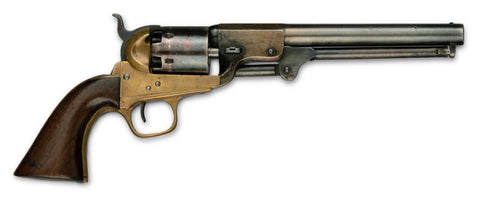
Made in the CSA: Southern Arms Makers Produced Pistols With Brass Parts to Save on Scarce Steel
Imitation is a sincere form of flattery, so the saying goes, but in the case of the Confederacy it was also due to necessity. Faced with a shortage of weapons when the war began, Southern arms manufacturers, including some 1861 start-ups (no pistol factories existed in the South when the war began) made copies of firearms that had been manufactured in Northern factories, including pistols.
Revolvers produced by the Colt Manufacturing Company in Hartford, Conn.—particularly the .44-caliber Model 1860 “Army” and the .36-caliber Model 1851 “Navy”—were the most frequently copied. At least 11 firms in Georgia, Mississippi, Virginia, and Tennessee made handguns of sound, albeit rough, quality for Confederate troops.
Recommended for you
One thing, however, that these firms could not copy compared to Northern gun producers was quantity. It is estimated that fewer than 10,000 Southern revolvers were made during the conflict by all Confederate firms combined. Just a drop in the bucket of what was needed.
In contrast, Samuel Colt’s armory cranked out 121,757 revolvers from 1861 to 1865, including nearly 60,000 Army revolvers in 1863 alone. Three Southern manufacturers—Griswold & Gunnison, Leech & Rigdon, and Spiller & Burr—made 70 percent of all Confederate revolvers. Pistols produced by those firms are featured here.
Most Confederate revolvers substituted brass parts
for steel when possible. Brass was a softer metal, and more prone to expanding
and contracting when heated. The Griswold & Gunnison frame was brass. Note the
“V” notch cut in the hammer. When the pistol is fully cocked it serves as the
rear sight, a common feature on wartime revolvers.
Thomas Leech and Charles Rigdon first
partnered in the Memphis Novelty Works of Tennessee to make swords and other
metal items for the Confederacy. By April 1863, the company, renamed Leech &
Rigdon, had moved to Greensboro, Ga., and was concentrating solely on making
its version of a six-shot .36-caliber Navy revolver.
Leech & Rigdon pistols were of
high quality, and brass was substituted brass for steel only on the backstrap.
The company was contracted to make 1,500 pistols, but only about 900 were
finished when the firm dissolved in December 1863. Looking closely at the
brass strap under the handle, you can see file marks from the manufacturing
process.
The Spiller & Burr firm started in
Richmond, Va., at the beginning of the war to make revolvers for the
Confederacy, but would eventually move to Macon, Ga. Its initial November 20,
1861, contract with the Confederate government called for 15,000 .36-caliber
revolvers based on the Colt Navy. Despite that fact, the pistols produced by
the firm, above, were actually copies of the Whitney Arms Company’s version of
the Navy, top.
The main difference with the Whitney
it copied was the Spiller & Burr’s use of a solid brass frame, grip strap, and
back strap. Due to very slow production, the Confederate government bought out
the firm in 1864. Regardless, only about 1,450 Spiller & Burr revolvers were
produced.
Various Confederate armories also manufactured
revolver ammunition. Troops didn’t use loose powder and balls, but most often
were issued boxes of six rounds, conical bullets with a paper cartridge glued
on to the base. This rare, still-full box was manufactured in the Confederate
capital.
